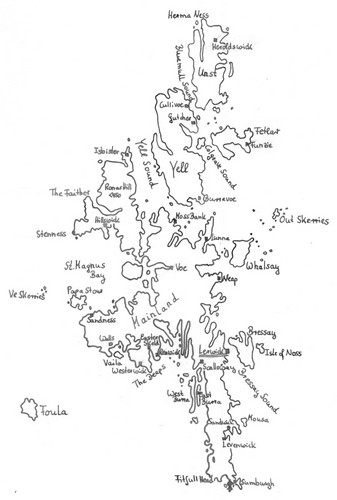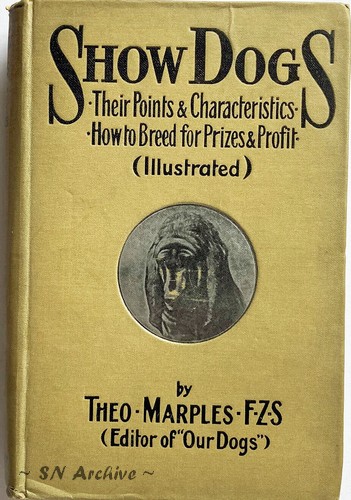 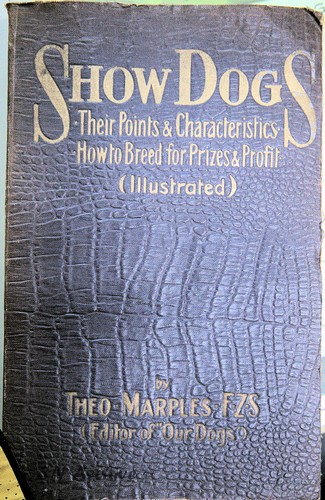 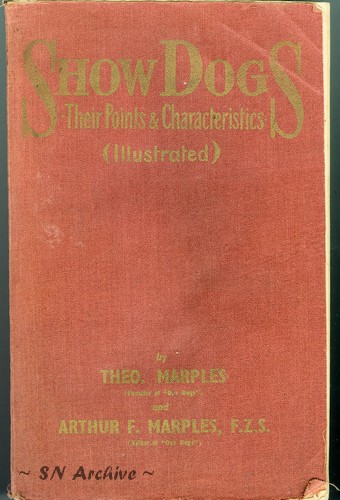 |
Show Dogs - Their Points & Characteristics How to Breed for Prizes & Profit (Illustrated) Theo. Marples FZS (Editor of "Our Dogs"), Our Dogs Publishing Company Ltd., GB 1915 (2nd edition) *3 1926 (3rd edition) *1 about 1932 (4th edition) |
The first edition of this book by Our Dogs editor Theo. Marples was published in 1907. "The chapters of this work have already run through the pages of 'Our Dogs' and the result of their incorporation and publication in book form is partly at the request of many fanciers, ..." [Preface To First Edition] A Review of this book was published in 1908-The Field, The Country Gentleman's Newspaper.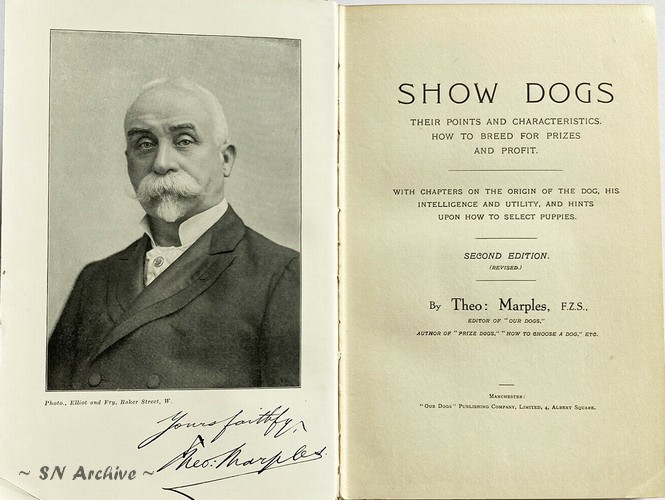 In the 2nd (revised) edition which followed in 1915, "... a different method of illustration has, it will be seen, been adopted, which the author hopes, will meet with the approval of its readers. Instead of photographs of more or less celebrated dogs which have adorned the british show bench, the author has selected the series of sketches of 'Ideal' dogs of the different breeds, which that very clever canine artist, Arthur Wardle, contributed to and which ran through the pages of 'Our Dogs' (which are reproduced by the special permission of 'Our Dogs' Publishing Company, Limited). The essence of the change of illustration lies in the fact of these 'ideal' drawings forming correct models for breeders to breed up to, and a guide to all persons who desire to possess the best specimens of the breed they severally affect." [Preface To Second Edition]
In the 2nd (revised) edition which followed in 1915, "... a different method of illustration has, it will be seen, been adopted, which the author hopes, will meet with the approval of its readers. Instead of photographs of more or less celebrated dogs which have adorned the british show bench, the author has selected the series of sketches of 'Ideal' dogs of the different breeds, which that very clever canine artist, Arthur Wardle, contributed to and which ran through the pages of 'Our Dogs' (which are reproduced by the special permission of 'Our Dogs' Publishing Company, Limited). The essence of the change of illustration lies in the fact of these 'ideal' drawings forming correct models for breeders to breed up to, and a guide to all persons who desire to possess the best specimens of the breed they severally affect." [Preface To Second Edition]
The 3rd edition (1926) Theo Marples "... called in the services of my son, Mr. Arthur F. Marples, Assistant Editor of 'Our Dogs,' who, like his father, had made a study of and association with the canine cult... The sketches of the newest breeds of dogs have been drawn by R. Ward Binks, whose beautiful canine portraiture is now so popular." [Preface Of Third Edition]
I have no date of the 4th edition but it was published after the death of Theo. Marples (1931 - 83 years old). "Since the third edition of this work was published my father has passed on. ... This edition has been brought up to date in every way ... New illustrations of ideal specimens have been provided for these new breeds and other illustrations have been substituted for breeds in which the fashion has changed. These have been sketched by Gerry Walker ..." [Preface To Fourth Edition]
The several editions are partly different in the breed description although the Shetland Sheepdog sketch did not change over the years.
Has anyone found out who is behind the pseudonym Juteopolis?
Perhaps it is Mr Forbes Grant of Dundee, who was instrumental in founding the Shetland Collie Club (as the name Juteopolis was given to the City of Dundee on account on its staple industry from 1850-1939?
2nd Edition: Page 174-176
"THE SHETLAND COLLIE
By 'Juteopolis.'
ITS ORIGIN, PAST HISTORY, AND PRESENT-DAY GENERAL
APPEARANCE AND USE DESCRIBED.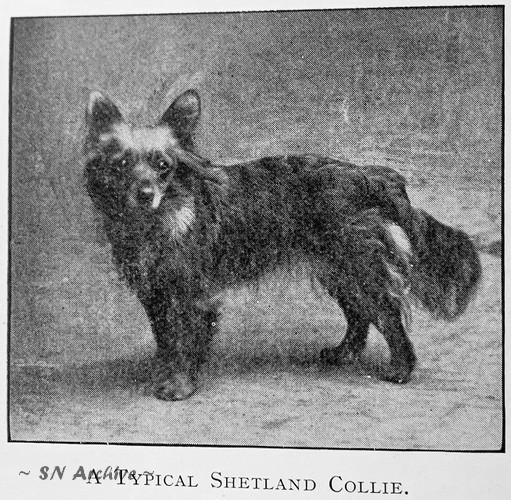 Of the actual origin of this dog, so far as can be gathered from authorities on the Island, there seems to be no certainty of actual data, other than of its being a very old breed of dog; in fact, it is as ancient as the Shetland pony, and bears the same relationship in size and appearance to our larger rough Collie of Scotland as the tiny Shetland pony does to our larger hackney. They are synonymous but in miniature. The average crofter, or 'small-holder,' in that country finds it hard fight to gather his crust from a not over-productive soil, and thus the laws of nature have stepped in and regulated the size of his beasts of work and burden. Of the breed it may be said, what the earliest writers in the pre-historic days would have said of our own Collie, that 'it was there when they touched this sphere.' Yet, if we believe the legend that the oldest native will spin out, some of the ancestry of the dog may be unearthed. He will tell us that his father told him that he remembered hearing his grandfather tell a story in reference to the dog in much the following words: 'One stormy, wintry day, some generations ago, some of the residents of the Island were startled by seing a small Scotch shipping craft in evident signs of distress off the Shetland coast. Its sails were torn to shreds, and it was being driven before a raging gale and tossed on mountainous waves like a cork. Time and again it tried to make for a cove, or haven of refuge on the mainland, but time after time the efforts of the skipper were frustrated, and eventually the climax came, when a great wave struck the frail craft broadside, landing her crash against a projecting rock. Five minutes later all that was seen on the water's surface were floating wreckage and a few struggling units, fighting against being engulfed in the sucking waters. Quickly all that cleared away except one little item that valiantly battled with the waves, ever and anon pushing its nose above the hungry and devouring waters, and bravely keeping its head shorewards until it was finally thrown up on the coast in an exhausted condition. On the spectators of this tragedy approaching it, it was discovered to be an animal - afterwards found to be a female of the species known as our Collie. A native, taking the ship-wrecked stranger in his arms, took her home, and a week later was rewarded for his trouble by seeing five little youngsters lying beside the mother.' If this legend is, as I say, to be believed, perhaps it is possible that from this collection the Shetland Collie has sprung. Naturally, of course, the collie would at that time be larger in size that it presently is, but, as is well known to dog breeders, such in-breeding would, in course of time, reduce it considerably. The reason, practically speaking, that the name Shetland Collie was given to it is that many years ago the Shetland Islands became better known, and evolved into holiday resords of considerable attraction, and tourists from all parts visiting these Island became fascinated with this small dog, which they bought, and after their return home the only name they could give it was a 'Collie from Shetland'. Hence, in time Shetland was placed in front of Collie in much the same way as the Collie from Scotland was spoken of as a 'Scotch Collie.' The true specimens of this dog are, and ought to be, an absolute replica of our ordinary Collie, but in great miniature. That he is now a true breed and type of a dog there is no denying, because at the moment he can, and has done for years, bred true to his size and type. In their earlier career I have no doubt they were used for driving and gathering the miniature sheep of the country, and even now they are not devoid of the instinct of such work, but in later years they seem to have been bred and reared more for pets than for utility. As a lady's or genteman's companion or pet he is excelled by few Toys, and he carries with him for his mistress or master the true, honest, and faithful heart of the larger dog, whilst he is intelligent and affectionate to a high degree. As yet there is no standard of points fixed for the breed, neither is there a club formed to secure Kennel Club recognistion for the variety, although at present there is an agitation en tapis on the part of some of the more ardent devotees of the dog to form such a club, and it can only be by such a formation that official recognition in the shape of having the Kennel Club place the dog on the list of breeds as a recognised breed can be secured, as was recently done with the dog now known as the West Highland Terrier. I notice that several clubs, notably Dundee, Glasgow, and the National Toy Dog Club at Edinburgh, are given distinct classes for the breed, which ought to bring the dog to the front.
Of the actual origin of this dog, so far as can be gathered from authorities on the Island, there seems to be no certainty of actual data, other than of its being a very old breed of dog; in fact, it is as ancient as the Shetland pony, and bears the same relationship in size and appearance to our larger rough Collie of Scotland as the tiny Shetland pony does to our larger hackney. They are synonymous but in miniature. The average crofter, or 'small-holder,' in that country finds it hard fight to gather his crust from a not over-productive soil, and thus the laws of nature have stepped in and regulated the size of his beasts of work and burden. Of the breed it may be said, what the earliest writers in the pre-historic days would have said of our own Collie, that 'it was there when they touched this sphere.' Yet, if we believe the legend that the oldest native will spin out, some of the ancestry of the dog may be unearthed. He will tell us that his father told him that he remembered hearing his grandfather tell a story in reference to the dog in much the following words: 'One stormy, wintry day, some generations ago, some of the residents of the Island were startled by seing a small Scotch shipping craft in evident signs of distress off the Shetland coast. Its sails were torn to shreds, and it was being driven before a raging gale and tossed on mountainous waves like a cork. Time and again it tried to make for a cove, or haven of refuge on the mainland, but time after time the efforts of the skipper were frustrated, and eventually the climax came, when a great wave struck the frail craft broadside, landing her crash against a projecting rock. Five minutes later all that was seen on the water's surface were floating wreckage and a few struggling units, fighting against being engulfed in the sucking waters. Quickly all that cleared away except one little item that valiantly battled with the waves, ever and anon pushing its nose above the hungry and devouring waters, and bravely keeping its head shorewards until it was finally thrown up on the coast in an exhausted condition. On the spectators of this tragedy approaching it, it was discovered to be an animal - afterwards found to be a female of the species known as our Collie. A native, taking the ship-wrecked stranger in his arms, took her home, and a week later was rewarded for his trouble by seeing five little youngsters lying beside the mother.' If this legend is, as I say, to be believed, perhaps it is possible that from this collection the Shetland Collie has sprung. Naturally, of course, the collie would at that time be larger in size that it presently is, but, as is well known to dog breeders, such in-breeding would, in course of time, reduce it considerably. The reason, practically speaking, that the name Shetland Collie was given to it is that many years ago the Shetland Islands became better known, and evolved into holiday resords of considerable attraction, and tourists from all parts visiting these Island became fascinated with this small dog, which they bought, and after their return home the only name they could give it was a 'Collie from Shetland'. Hence, in time Shetland was placed in front of Collie in much the same way as the Collie from Scotland was spoken of as a 'Scotch Collie.' The true specimens of this dog are, and ought to be, an absolute replica of our ordinary Collie, but in great miniature. That he is now a true breed and type of a dog there is no denying, because at the moment he can, and has done for years, bred true to his size and type. In their earlier career I have no doubt they were used for driving and gathering the miniature sheep of the country, and even now they are not devoid of the instinct of such work, but in later years they seem to have been bred and reared more for pets than for utility. As a lady's or genteman's companion or pet he is excelled by few Toys, and he carries with him for his mistress or master the true, honest, and faithful heart of the larger dog, whilst he is intelligent and affectionate to a high degree. As yet there is no standard of points fixed for the breed, neither is there a club formed to secure Kennel Club recognistion for the variety, although at present there is an agitation en tapis on the part of some of the more ardent devotees of the dog to form such a club, and it can only be by such a formation that official recognition in the shape of having the Kennel Club place the dog on the list of breeds as a recognised breed can be secured, as was recently done with the dog now known as the West Highland Terrier. I notice that several clubs, notably Dundee, Glasgow, and the National Toy Dog Club at Edinburgh, are given distinct classes for the breed, which ought to bring the dog to the front.
I have been told that once a Collie, purporting to be a Shetland Collie was, many years ago, shown at the Kennel Club's Show in London, but from the comments passed on it at that time it did not seem to command favour or create great impression. Hence I assume it had not been a typical specimen. The general description may be summed up pretty well as follows: ---
The average WEIGHT is about 7lbs. for bitches, and up to 10lbs. or thereby for dogs.
LENGTH OF BODY, from root of tail to shoulder, 15 ins.
HEIGHT AT FOREARM, 9ins. to 10 ins.
LENGTH OF HEAD, from occiput to tip of nose, 5 ins. to 6 ins. The head should be flat and not over thick in skull, with the muzzle tapering to the nose; mouth clean teethed and level.
EARS. - Semi-erect, small, and placed high on the head.
THE EYES should be well placed and small and dark, with the ordinary intelligent Collie expression.
THE FRONT LEGS are straight, strong boned, and short, and beautifully feathured, with plenty of chest frill.
HINDQUARTERS strong and well feathered, with legs clean.
TAIL well feathered and carried as the ordinary Collie.
COLOUR. - They are found in various colours, such as black-and-tan, back-tan-and-white, black-and-white, sable-and-white, and, in that northern climate, they may be found wholly white.
THE OUTER COAT is long and glossy, a trifle softer in texture than the ordinary Collie, but with the usual woolly undercoat. This softness of out coat may perhaps be accounted for by climate conditions. For instance, the little Shetland sheep carries a much finer, softer, and more valuable coat than the sheep of our country.
Although the head at the moment may not embody the same tapering muzzle or narrowness of skull that we see in our present Collie, yet it still carries the same true Collie expression, and the fact of the skull not being narrower or the muzzle longer will simply be the result (as has happened in many other breeds) of want of care or neglect in mating, or having no standard laid down to breed up to, just as the face of our Collie thirty years ago would barely be recognised alongside the best dogs of the present day. With care, there is no necessity why the head of the Shetland Collie should not, in time, resemble the head of our Collie, as the breed now does in all other respects.
In supply they are medium, but thoroughly good and typical specimens, such as traced above, are not over plentiful, and these latter command pretty high prices. As breeders they are very fair, but the puppies require a considerable amount of attention and care in rearing.
So far as can be traced no record of pedigrees has ever been kept other than a breeder here and there naming his dogs, and keeping a note of the litters.
Several of our aristocracy, notably Lady Marjorie Gordon (now the wife of the Scottish Secretary, Capt. Sinclair), Her Excellency the Countess of Aberdeen, and many others of note, have taken a great interest in this dog, and brought it into prominence, and it is now much sought after. The natives of the Islands are, however, quite alive to its value as a marketable commodity.
Knowing how keenly interested Lady Marjorie was in the variety, I placed myself in communication with her to obtain her experience of this dog, and I cull from a very interesting letter which I have received the following extract: ---
'The first one I had was a beautiful little red or sable one, the finest I have ever seen, and it was given me by a Spanish gentleman, who had its brother. He got them both, I believe from a banker in Aboyne, who had had them sent from Shetland. This red one I called 'The Cid,' and he was very much admired in London and elsewhere. I once showed him at Aberdeen and at a Toy Dog Dog Show, but here was no class for him, of course. I found him very affectionate and intelligent. One time I took him away to stay at a place ten miles off (where he had never been) in the foot of a waggonette, and after arriving, as he could not find me, he got home in an hour. Unfortunately, in 1903 he got suppressed distemper, which produced chorea, and after a long illness he died and buried at Dollis Hill. I found him quite strong usually. The next one I got was through a gentleman in Aberdeen. She was black-and-tan, with a very pretty glossy wavy coat. She was called 'Brenda', and is now living in Roxburghshire; and she is very affectionate. Sir Allan MacKenzie got me another black-and-tan one from Shetland, and we hoped to breed from him and Brenda, but he died. I have several times seen others. One I know is owned by Mr. Macdonald, of the Scottish Education Department in Edinburgh, and another is the constant companion of Mr. Cathcart Wason, M.P. for Orkney and Shetland. It is a small black-and-tan, with rather short legs. Lady Aberdeen was much interested in the breed, and endeavoured to get information about them through the canine papers. With best wishes, - Yours truly,
'(Signed) MARJORIE SINCLAIR.'
Such then, in the main, is a fair summary of this smart little Toy, most of the particulars for which were gathered by myself personally in the course of a tour through Orkney and Shetland Islands, whiles I have to thank a number of connoisseurs of the dog resident in the Islands and in this country for many notes of interest.
The chief points to look for in the selection of Shetland Collie puppies are identical with those of the Scotch Collie, except, of course, on a less scale."
3rd Edition: Page 264-266, "CHAPTER lX. and
4th Edition: Page 282-285 (same text and drawing)
----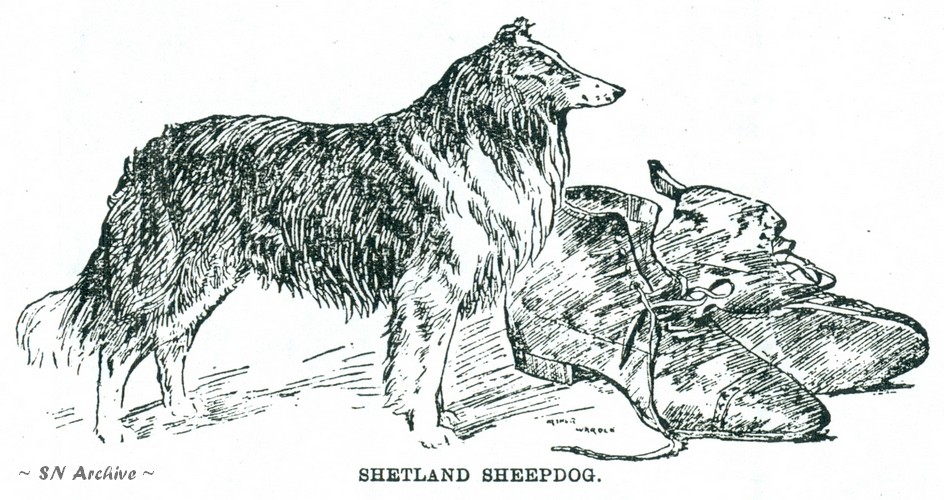
The Shetland Sheepdog.
The name of the Shetland Sheepdog clearly indicates his origin and habitat. The Shetland Isles are noted for their horses, cattle, sheep, and dogs, all being in miniature. Whether these dwarfed animals on the Island are a provision of Nature, as adapting them the better for their Island home and haunts, or their bantamising has been the work of the Islanders, is a subject which I need not discuss here. Suffice it to say that the Shetland Sheepdog is in perfect keeping with his other companions. This is in the fitness of thinks, for it would indeed look strange if the orthodox Scotch Collie were to roam about the Islands amongst the miniature cattle, some specimens of which would exceed in size many of the latter!
It is a few years since the Shetland Sheepdog found his way on the show bench and fell into the hands of the fancier, who, of course, immediately began to exploit him; and later still the Kennel Club admitted the dog on its register as a distinct breed. On the Islands the dog, like other sheepdogs, is employed for herding the sheep and cattle, and therefore requires the same points as his enlarged brother, who is built for and used for the same purpose. The points of the Scotch Collie have been formulated by experts, and on such well-attested lines as should enable him to prosecute his calling with the greatest facility, and it must be admitted that by years of careful selection and breeding the larger edition has been brought to very great perfection, and is one of the finest examples of canine culture extant.
Bred on the Islands, indiscriminately no doubt - not even by rule of thumb, - the original specimens of Shetland Sheepdog were, and are, naturally of a somewhat nondescript pattern. The only consideration which the Shetland farmers had originally in mating their sheepdog bitches would be proved working qualities in the dog to which they were to be mated. Such features as narrow shoulders, straight forelegs, well-sprung ribs, strong loin and quarters, dense weather-proof coats, intelligent eyes, and suitable carriage of ear, were in ninety-nine cases out of every hundred probably points in the anatomy of a Sheepdog which never entered into their philosophy, although all very necessary qualifications and very advantageous to the dog in his specific calling.
That is why I can never understand the force of those who argue that the Shetland Sheepdog should be kept to his original type, which is really no type at all. In the earliest exhibition day of the Shetland Sheepdogs there were all sorts and sizes of dogs shown as Shetland Sheepdogs, many of them hailing from the dog's native heath. Some were more on Pomeranian than Sheepdog lines, and many showed traces of the Spaniel in their physiognomy and anatomy.
If in the various breeds of dogs - or, indeed, any domestic animal - we were stick to originals, we should not have the beautiful dogs that are on the show bench to-day. If this conservative theory is to be carried to its legitimate end - that is, to the original dog - we should have now only one breed!
The various beautiful breeds we have to-day in England, and which are the wonder of the world, have not been produced by sticking to originals, but judicious and rational selection, with the one object of improvement in view. The Scotch Collie, as seen at his best on the show bench, is the finest example in the world of a Sheepdog possessing all the attributes, anatomically, to fit him to fulfil his work to the best advantage. Why cannot our Shetland friends take the advantage of the half-century's work of their friends and copy the larger model and make the Shetlander a replica in minature of his big brother? And the best way to do this is to breed the Shetland bitches to undersized Scotch Collies. Out-crossing in these days of consanguinity is an absolute necessity, and could there possibly be a better outcross for the Shetlander than the Scotch Collie, who possesses every attribute required except size?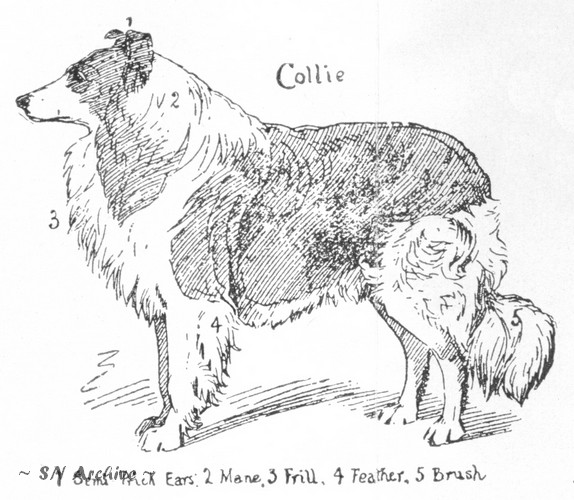 The colours of the Shetland are the same - sable-and-white and tricolour.
The colours of the Shetland are the same - sable-and-white and tricolour.
The points to choose for in a puppy are identical with those given in the case of the Scotch Collie, except with regard to size - the smallest puppies in the litter, given other good points, being those to select.
The following is the standard description and points of the Scottish Shetland Sheepdog Club: ---
....
The standard of type contained in the Constitution of the Shetland Sheepdog Club is as follows: ---
'The type and points of the Shetland Sheepdog shall be similar to those of the Rough Collie in miniature. The height of the Shetland Sheepdog shall not exceed 15in.' "
If you discover any errors in the text that may have been caused by the transcription, please let us know for a prompt correction.
*1 Original in Eva-Maria Krämer collection
*3 Original in Reidun Monsholm collection

